Electroscope for Measuring Radioactive Gases (ca. 1908-1930)
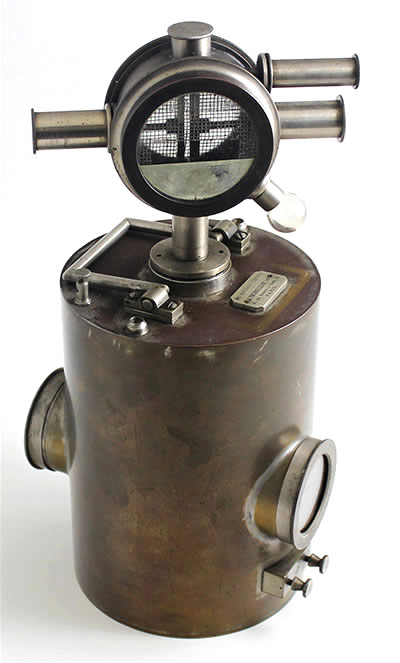
This hybrid device consists of a rather sophisticated electroscope mounted on the body/chamber of an older and simpler electroscope. It would have been used to analyze radioactive gases (i.e., radon).
Who assembled this device is unknown. Similarly, nothing is known regarding where and when this was done. it is almost certain however that it was done to produce a more reliable instrument than the electroscope that became the chamber of the current instrument.
There are no markings of any kind on the electroscope, at least that I could find—nothing that would indicate the manufacturer. Nevertheless, it is somewhat similar in appearance to electroscopes produced by L. Deffez of Paris and those manufactured by Societe Centrale de Produits Chimiques also of Paris. The electroscope is unlikely to have been produced much earlier than 1910 or later than 1930.
Aside from the missing microscope, it is in superb condition. Perhaps the most interesting thing about it is that it has the characteristics of two different electroscopes: that designed by Cheneveau and Laborde and the modified Exner electroscope described by Elster and Geitel.
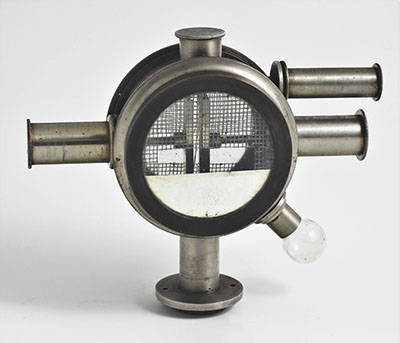
Like the electroscope of Cheneveau and Laborde, the above:
- has a metal screen applied next to each of the two glass windows.
- has an attached small spherical glass bulb that would contain a desiccant.
- is mounted on top of, rather than below, the chamber.
Like the electroscope of Elster and Geitel, it:
- employs two aluminum leaves rather than one.
- has a mirror on the bottom portion of the viewing window to correct for parallax.
Size: ca. 6" tall and 3.5" diameter
The Chamber
The metal tag on the top of the chamber (photo below) indicates that it was manufactured by Jules Thurneyssen. From about 1903 until his death in the late 1920s, Thurneyssen produced and sold various types of scientific equipment at 58, Rue Monsieur-le-Prince, Paris.
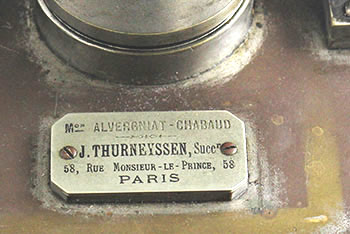
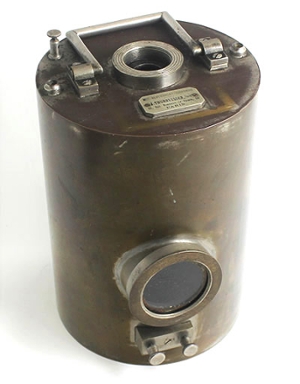
Originally, this three liter brass chamber formed the body of the electroscope that Thurneyssen sold as part of the Danne apparatus (probably between 1908 and 1914). This "apparatus" is illustrated in the following figure taken from a 1910 paper by Pinto Oliveira (“Primeira contribuição para o estudo da radioactividade das águas minerais de Portugal” Rev. de Chim. Pura e Ap.; I Série, 6.º Ano, pp. 269-279).
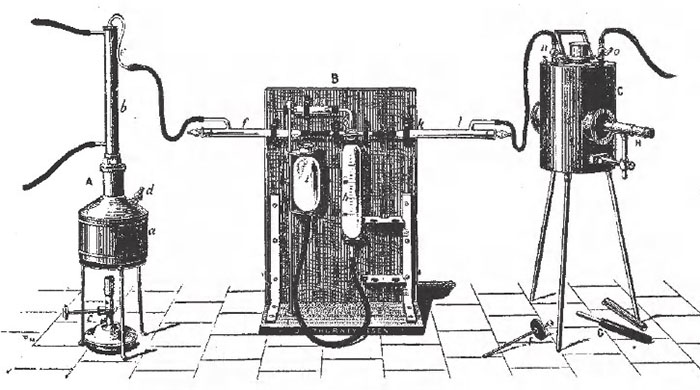
That Thurneyssen sold the Danne apparatus as early as 1908 is indicated by the following product listing (Bulletin des Seances, Société Française de Physique).

The electroscope, on the right side of illustration, had three legs that would position the microscope (H) at eye level for someone sitting at a bench. Using the microscope, the electroscope’s leaves would have been viewed through the circular glass window on the side of the chamber (C). The leaves were attached to the bottom of an amber rod suspended from the top of the chamber.
Jacques Danne, editor of Le Radium and colleague of Pierre Curie, was familiar with more precise measuring devices than the simple electroscope in the “Danne apparatus.” Nevertheless, Danne probably intended it to be simple. A likely explanation is found in the following quote from the Scientific American Supplement No. 1894 (1912):
“The quantitative determination of radium is preferably made by the “piezoelectric quartz method” [invented by P. Curie], but it can also be effected by means of the apparatus shown in Fig. 4 [see below] which M Danne has devised especially for the use of persons unfamiliar with radioactive measurements.”
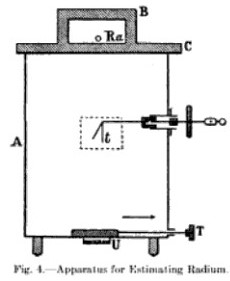
Although the electroscope in figure 4 analyzed solid samples while that in the Danne apparatus analyzed gases, the point is that both were simple enough to be used by relatively inexperienced researchers. Unfortunately, such simple instruments would lack precision.
It is reasonable to speculate that whoever assembled our device had been dissatisfied with the performance of their “Danne electroscope.” As such, they might have removed the leaves and microscope so that it simply served as the sample chamber (two small pieces of aluminum foil can still be seen inside the chamber). Connecting the chamber to a high quality electroscope like the one in our example would be a simple matter. The legs of the Danne electroscope would have been removed to keep the microscope (missing) at eye level—the three attachment points for the legs are visible on the bottom of the chamber.
Size: Approximately 9" tall and 6.5" diameter
Electroscope of Cheneveau and Laborde for Analyzing Radioactive Gases
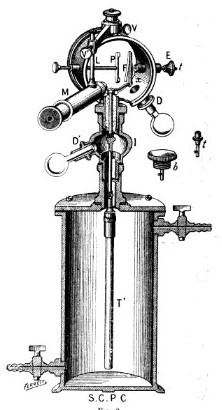
For what it is worth, the hybrid instrument in the ORAU collection is similar to an electroscope for analyzing radioactive gases that was described by C. Cheneveau and A. Laborde in 1908. The following image is taken from their paper." Appareils pour la Mesure de la Radioactivite, d'apres la Methode Electroscopique." (Bulletin des Seances de la Société Francais de Physique, pp. 262-275, 1908).
I would like to express my thanks to Jean-François Loude for his assistance.
